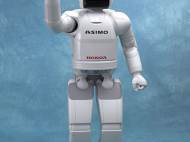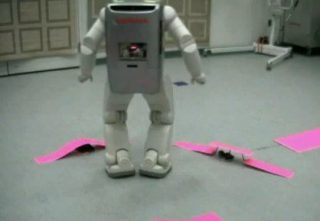Honda ASIMO robot footstep planning
 One of the most advanced contemporary humanoid robots ASIMO has been developed since 1980s. In a couple of our future articles we’re going to write about ASIMO’s features. In this article we’re going to write about its footsteps planning algorithm. The possible future foot placement positions are dependent on the current state of the robot. Using a finite set of state-dependent actions, they used an A* search algorithm to compute optimal sequences of footstep locations up to a time-limited planning horizon. The experimental results demonstrate the robots navigation through both static and dynamic known environments that include obstacles moving on predictable trajectories.
One of the most advanced contemporary humanoid robots ASIMO has been developed since 1980s. In a couple of our future articles we’re going to write about ASIMO’s features. In this article we’re going to write about its footsteps planning algorithm. The possible future foot placement positions are dependent on the current state of the robot. Using a finite set of state-dependent actions, they used an A* search algorithm to compute optimal sequences of footstep locations up to a time-limited planning horizon. The experimental results demonstrate the robots navigation through both static and dynamic known environments that include obstacles moving on predictable trajectories.
Researchers at Carnegie Mellon performed their experiment on the Honda ASIMO robot. The tests were performed on a hard flat surface in an area three meters on each side. The terrain representation used cells that were 0.025 meters per side. The environments and start and goal locations were provided to the planner, and the robot executed the commands dictated by the planner’s result.
An environment with static obstacles was built on the hard flat surface. Each static obstacle is represented by a colored rectangle. The circles in the environment represent the start and goal locations for the robot. Different scenarios were applied, where they varied robot’s start and goal positions. In each case, the planner successfully returns a set of commands that allow the robot to move from the start to the goal while avoiding the obstacles. The robot could also decide to step over the obstacles, utilizing its biped capabilities.
The algorithm was also tested in an environment with predictable dynamic obstacles. There are two rows of colored rectangles representing the moving obstacles. Each row of obstacles is attached to strings that are then attached to an electric motor. The strings are also represented in the environment as places upon which the robot cannot step. There are two motors, each of which pulls the strings to one side, thereby moving the obstacles. The two rows of obstacles have a regular spacing between the blocks, although the spacing is different for each row. The first row moves at 0.1 meters per second, and the second row moves at 0.18 meters per second.
In that environment, the standard mobile robot planner fails, as the start and goal are in disconnected areas of the environment. The ability of the robot to step over the strings connecting the blocks enables it to reach the goal location.
In their test, the robot successfully steps through the dynamic obstacles. It is interesting to note that when passing through the second row of obstacles, the robot sidesteps to wait for an obstacle to move past before stepping through them.
This in an important robot feature of the future robot development as the robots meant to serve need to adjust to the world around them, thus making it save both for humans and themselves.










Leave your response!